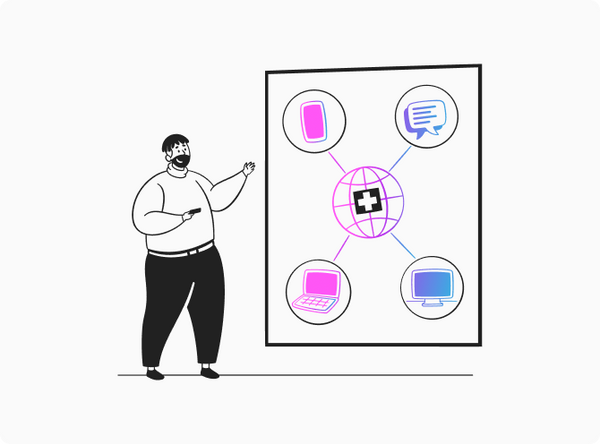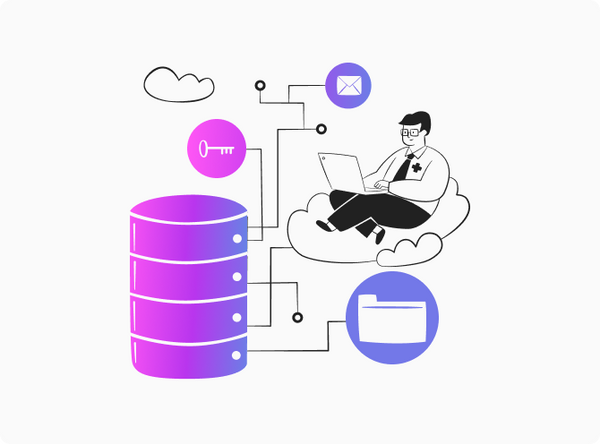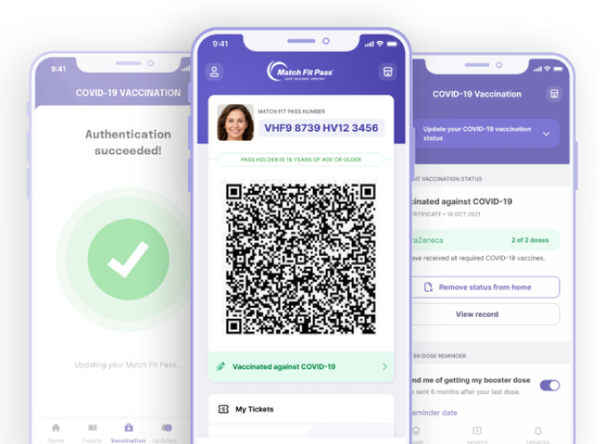
According to Singlecare, since the COVID-19 pandemic started the use of virtual care has increased by 38 times compared to the pre-pandemic stats! Such whopping numbers show that people do realize the benefits of telehealth and the potential that this industry carries as a whole.
In this post, we'll examine five innovative telemedicine app examples as well as take a look at some other components of telehealth and telemedicine to understand what is currently trending in this niche and why.
What is Telehealth and Telemedicine
Even though these two terms look similar, they aren't quite the same. Let's look at what telehealth and telemedicine mean.
Telehealth — a form of E-health that combines all technologies and tools used for the delivery and improvement of medical services or systems. Compared to telemedicine, telehealth covers the broader spectrum of devices and technologies used in healthcare.
Telemedicine — a subcategory of telehealth that focuses only on the delivery of medical services (or education) over a distance. In other words, telemedicine deals solely with remote devices, wearables, etc. while telehealth works with medical information and improvement of the daily work of healthcare professionals in general.
Now we've figured out the differences between these two concepts, let's see which technologies are normally used for the creation of telehealth products.

What Are Telehealth Technology Examples Used in App Development
Big Data
As it is with any other industry, in healthcare the ability to correctly gather and process data and derive the necessary conclusions from it meanseverything. The collection of big data allows physicians to make more informed decisions regarding treatment, thus reducing the risk of human error. Doctors can identify the early signs of a disease and start treating it at its early stages before it progresses.
On a larger scale, the ability to effectively work with big data allows healthcare institutions to map out health trends that are common for a particular group of people, region, or period of time. The kind of medical data that is normally gathered by healthcare professionals is the medical information of the patients, hospital records, information collected from various medical devices (testing machines, wearables), and medical exam results.
Artificial Intelligence
AI is one of the driving forces for healthcare and has helped to shape the telehealth sector into what it is today. From the comprehensive analysis of medical records to assisting in personal consultations, Artificial Intelligence helps to extract important insights and identify upcoming trends. Thus, allowing healthcare facilities and institutions to improve their work.
AI technologies aid physicians in producing more accurate diagnoses, keep them from burning out, as well as improve the quality of medical services delivered to patients.
Additionally, Artificial Intelligence helps to make hospital visits easier for patients (especially for elderly people) and reduces their wait times. AI also keeps the medical staff constantly informed of the patient inflow, hospital capacity, and sources of potential operational problems.
Blockchain
Establishing secure management and transfer of medical data has been one of the main concerns in the industry ever since telemedicine products were adopted around the world. With the help of a blockchain, security isn't an issue any longer. Thanks to the blockchain's distributed ledger structure, doctors can share patient data without compromising any sensitive information.
Patients have full control of their data while healthcare professionals can access it no matter the time of the day or their location. Blockchain can also significantly boost the process of issuance of medical orders, patient bills, etc.
IoT
In healthcare, the term IoT is better known as IoMT which stands for the Internet of Medical Things. It combines a diverse range of medical devices and other equipment connected to the cloud. Portable medical machines, wearables, and other biosensory gadgets all fall into this category.
With the help of IoMT, doctors track patients’ vitals in real-time. By doing so it is possible to establish an ongoing evaluation of a medical condition — or disease stage — and compile a prognosis or take preventative measures if needed.

What are Types of Telemedicine Apps for Healthcare
Live telemedicine apps
Live telemedicine apps are used to connect patients with doctors online. Think of a live telemedicine app as a 'Zoom for healthcare' type of product. It replaces in-person consultations with online appointments during which patients get to meet with physicians on a video call or via text chat.
Remote Patient Monitoring (RPM) apps
These are apps that allow doctors to monitor patients’ health outside the hospital walls. Such solutions work either in conjunction with wearables or wireless medical devices from which they receive data or as questionnaires where patients throughout a day manually input updates regarding their current health state.
'Store-and-Forward' apps
This is another type of RPM app that permits healthcare specialists to gather information (via video or photos) from the patient to make a diagnosis or compile a relevant treatment plan. This type of telemedicine app is especially popular among dermatologists where patients forward skin images to their therapist for an evaluation. Artificial Intelligence and Machine Learning technologies have been widely adopted for these types of telehealth apps as well.
mHealth apps
These are basically patient health portals where users can access all their medical information in a convenient form. Such products are normally linked with the healthcare organization that provides medical services to the patient. The organization's staff is responsible for updating patient information, uploading exam results, etc. Patient billing reports, appointment calendars, and electronic prescriptions are all stored on these platforms too.
Collaborative apps for specialists
Collaborative telehealth apps are created to improve the cooperation between different healthcare professionals or even departments within a single hospital. They are commonly considered project management tools or solutions for healthcare. These solutions normally feature staff chat where therapists can communicate and share medical files, access dashboards, and some other coworking functionality.

Telehealth Devices Examples
Telemedicine carts
This is a type of mobile wireless apparatus that comes with integrated cameras, displays, and other medical equipment that allows for the remote delivery of quality healthcare services to patients. Such devices come in handy, especially in rural areas where people don't have access to physical hospitals or care clinics.
Telemedicine kiosks
These are 'mobile hospitals' or 'doctor's offices' that can be placed anywhere from shopping malls to business centers, parks, or other public spaces. The main advantage of telemedicine kiosks is that the patient doesn't have to schedule an appointment as they can go to the nearest kiosk to see the specialist there, whenever needed.
High-def cameras
The quality of the image is extremely important in healthcare. The accuracy of diagnosis may directly depend on the quality of the image the physician gets — take skin diseases as an example. Let's also not forget that in order to train AI in healthcare, specialists load it with images, and the better quality of images AI gets, the more accurately it will be able to identify the type of illness and its stage.
Telemedicine kits
Kits are smaller versions of telemedicine carts. These portable telemedicine systems are the size of a briefcase so they can easily be transported right to the doorstep of a patient.
Telemedicine kits can carry various medical devices needed for conducting a comprehensive medical exam on-site. They may also be wirelessly connected to the hospital system and send exam results to the cloud right away.
Telemedicine software
This category includes HIPAA-compliantsoftware used to connect doctors and patients as well as digital tools designed to ease the daily routine of healthcare specialists. We are talking about facility-based software: hospital management systems, health information portals, EMR solutions, etc. Read more about these in our article: 10 Telemedicine Business Ideas for Successful Startup.
Mobile medical devices
These are the devices used for remote monitoring of patient vitals. Wearables, wireless scales, Bluetooth pulse oximeters, smart thermometers — this is just a basic list of telehealth devices examples that are currently utilized in healthcare.
Best Telemedicine Apps Examples
Now let's check out 5 innovative examples of telemedicine apps and see what functionalities they offer to the users.
MDLIVE
A telehealth platform that is focused on providing non-emergency medical services. It can be used to treat more than 80 various concerns, including COVID-19, flu, mental health conditions, depression, and bipolar disorder.
Among the main pros of this service are the ability to choose your own physician, schedule appointments for kids (aged 10 years and above), and the integration of video service allowing you to connect with the therapist of your choice over the video, phone, or live chat. The last option would be especially helpful for users with hearing impairments.
Disadvantages of MDLIVE are the limitations connected with the therapist’s availability or certain types of medicines that physicians may not be able to give a prescription for.
Doctor on Demand
This platform provides users with access to the full range of medical professionals and mental care specialists. Doctor on Demand is available both on desktop (pc) and mobile for patients with flu symptoms, chronic health conditions, migraines, seasonal allergies, etc. This teledoctor app example also fits those who want to apply for seasonal or preventative health checkups.
One of the main benefits of this platform over other examples of telehealth appsis that it works with most insurance providers, so you might not have to worry about whether your provider will cover the cost of services. As to the platform's drawbacks, here you may be limited with the number of therapists to choose from, depending on your location, and may not be able to get prescriptions for some types of medicines.
Talkspace
Talkspace is geared around providing mental health services to people experiencing anxiety, stress, depression, eating disorders, LGBTQIA+ related abuse, etc. The platform comes with user-friendly functionality allowing patients to easily book e-therapy sessions. On Talkspace, patients can communicate with therapists via text, voice, and video messages.
As to the downsides of the service, some users say that at times the responses they get from the therapists may feel short or 'surface-level' in comparison to in-person visits. You may struggle to establish an emotional connection with the online therapist and feel like they don't get to know you on a level sufficient for providing quality consultation.
Spruce Health
Being HIPAA-compliant, Spruce Health is used for the facilitation of quality communications between doctors and patients. Aside from such standard features as voicemails, video calls, and online payments, Spruce also allows doctors to share files within teams and automate the delivery of medical services in general by giving physicians access to internal EMR, charts, shared notes, etc.
In a nutshell, this is an all-in-one platform that may come in handy for both patients and medical institutions as it has a well-developed B2B functionality on board as well. Spruce has three pricing plans and offers a 14-day free trial period to test them out.
Teladoc Health
A multifunctional platform that provides telehealth services in six major categories: telehealth, virtual care, support and guidance, platform services, and expert medical and mental services.
Teladoc is a good telehealth video app example that is focused on treating non-emergency situations, such as flu, infections, pink eye, sinus issues, and others. There are more than 3000 physicians and nurses offering services on the platform in 30+ languages.
Consider Lunka.tech Your Partner
When opting for our telemedicine app development services, not only do clients get a team of dedicated developers, but also the accumulated experience of years of working on various digital projects (telehealth included).
Among successful telehealth app examples that we at Lunka.tech have worked on are such products as Salus Optima— a telemedicine mobile application example that partners with different organizations in health and wellness fields helping them develop and deploy digital solutions, and Match Fit Pass — a telehealth mobile app example that combines the functionality of an e-health product and mobile ticketing service, letting users buy tickets to sporting events while also allowing them to store all the test results and vaccination QR codes within an app.

Final Thoughts
The future is already here: with the help of telehealth apps, patients receive a vast variety of healthcare services from the comfort of their living rooms. However, the telemedicine industry won't stop there and continue to evolve, bringing along new technologies and tools to make the delivery of medical services accessible to more people in different parts of the world.
We hope that you found this review of popular telemedicine platform examples useful. If you want to learn more about different types of telemedicine apps, check our article here.
If you’re looking for a telemedicine app development company to help with your project, contact us at Lunka.tech. We have a large portfolio of completed products, including examples of telehealth and telemedicine apps, and can effectively work with projects of different sizes and budgets.
FAQ
What are the three major ways telehealth services are delivered?
As of today, there are three categories or ways telehealth can be delivered: in real-time, asynchronously, or via remote patient monitoring. 'In real time' means providing patients with live consultations with the help of video conferencing tools. Asynchronous, a 'store-and-forward' method that gathers under one umbrella all the tools that collect, store, and process patient data. Such telehealth systems examples are critical for situations where a healthcare professional needs to get a patient's medical information instantly, without spending hours or days collecting it from different sources. The remote patient monitoring (RPM) category comprises wearable devices used to monitor patient medical state remotely and transmit vital data to the healthcare provider.
Is telemedicine the same as video conferencing?
While video conferencing technology is indeed a part of the healthcare industry, telemedicine is not limited to video calls only. With the help of telemedicine tools, not only can patients connect with their physicians in real-time, but also get digital prescriptions, pay for healthcare services, and browse through doctor catalogs and knowledge bases. In other words, in healthcare, video conferencing technology gets tailored to the needs of both doctors and patients.
What are the pros and cons of telehealth?
Among the most prominent advantages of the best telehealth app examples and telehealth as a whole are cost reductions, the convenience of use, and the ability to deliver medical services in remote locations or those regions where people don't have access to quality healthcare. As to the downsides of telehealth, these are limitations regarding the type of services that can be provided, public concerns related to the security of the health data gathered and processed by the telehealth apps, and no established policies regarding the insurance coverage for the telehealth services and products (on the industry level).
How can we start working on my telemedicine project?
If you are interested in the development of your own telemedicine app, you can contact us in any way that is convenient for you — via phone, email, or by filling the contact form on our website. We'd be glad to discuss your project in greater detail and see how our team can be of help!



